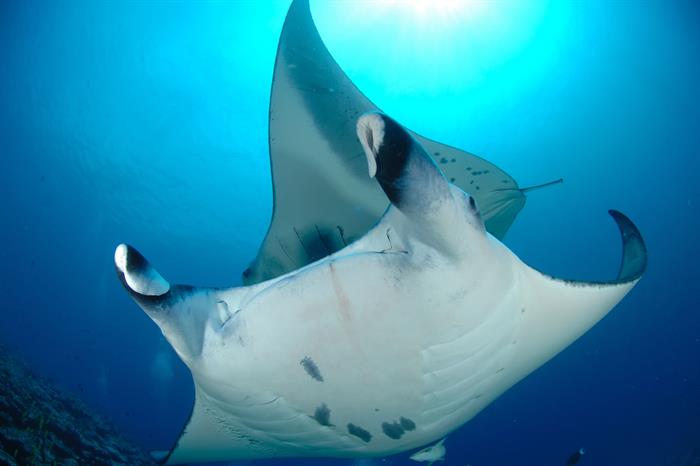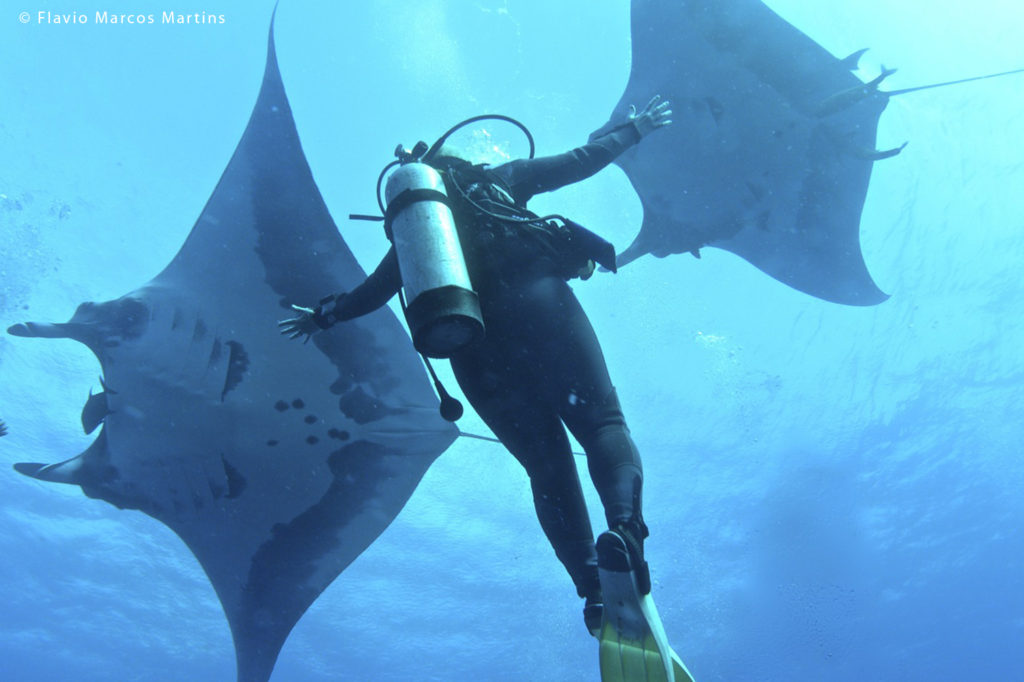Diving with Manta Rays
Diving with Manta Rays has to be on most divers wish list, and with good reason. These majestic creatures, a member of the shark & ray family, can grow up to 7m/23ft in length and can weigh up to an astounding 2 tonnes in weight! However, these gentle giants feed on tiny zooplankton, funnelling it into their mouths using 2 large lobes at the front of their head.
With one of the largest brains in the fish world, there are 2 separate species of Manta Ray. The Manta birostris, or Giant Oceanic Manta, which can be sighted along productive coastlines and are known to travel great distances. The Oceanic Manta has an average wingspan of 5m/16ft.
The Manta alfredi, or reef manta, is smaller in size with an average width of 3m and is generally spotted in shallow coastal areas.
Scuba diving or snorkeling with Manta Rays truly is a magical experience and one you will remember for a lifetime. Despite their size, these beautiful creatures are incredibly graceful in the water, and even playful, swimming in and out of exhaled bubbles and barrel rolling mid-water to show off their elegance. Manta Rays generally stop off at ‘cleaning stations’, where numerous different fish such as butterflyfish and cleaner wrasse hang out waiting for larger fish to swing by for a clean-up, similar to a car wash!
Best places to dive with Manta Rays
Due to the vast distances these gentle giants cover, Manta Rays can be spotted in many places around the world, however, there are some places that offer better chances of diving with Mantas than others. Many liveaboards in these areas have itineraries that visit specific dive sites to enable divers and snorkelers the chance to see these creatures in their natural habitat.
Socorro Islands – Known for having the ‘worlds friendliest Manta Rays’, the Socorros in Mexico is one of the best places for real up-close Manta-Ray encounters. These Giant Pacific Mantas congregate in large numbers at San Benedicto and use the cleaning stations there at the submerged seamount. Known to get extremely close to divers, this makes for fantastic photo opportunities, especially as the mantas are there year-round.
Komodo National Park – With a dive site name like Manta Alley you can guess why this is a popular spot in the national park. This submerged seamount, which can be quite prone to current, has been known to have as many as 50 mantas at one time! The plankton-rich water is what brings in the mantas in high numbers. But Manta Alley isn’t the only place to play with mantas in Komodo, dive sites like Makassar Reef, Batu Bolong and Golden Passage also promise amazing manta interactions.
Bali – Another manta hotspot in Indonesia is the small island of Nusa Penida off the south-east coast of Bali. There are two spots there, Manta Bay and Manta Point. Manta Bay is ideal for snorkelers as this shallow bay is more protected and quite shallow. Manta Point, also great for snorkelers, offers an amazing dive experience when the mantas are there between July – September. Up to 20 mantas have been spotted on one dive at Manta Point, where they come in to get cleaned by the local fish at the cleaning station.
Maldives – If you’ve seen the photos of huge numbers of mantas in a large train-like formation, barrel-rolling around, it was probably at Hanifaru Bay in the Maldives. Gathering in their hundreds, these amazing creatures come for a feeding frenzy in the plankton-rich waters. Hanifaru Bay in Baa Atoll is now limited to snorkelling only, but being in the water with up to 200 manta rays is an experience in itself, especially when whale sharks also come to join the mantas in this plankton-feast! The best time of year to head there is between May – November, during the north-west monsoon.

Protecting Manta Rays
Unfortunately, despite their beauty and grace, these majestic creatures are classed as ‘vulnerable’ on the International Union for Conservation of Nature (IUCN) Red List of threatened species and were also listed on Appendix I & II of the Convention of International Trade in Endangered Species (CITES). They are threatened by overfishing and line entanglement. Manta Rays need to keep swimming in order to breathe and are unable to swim backwards, so any line entanglement doesn’t bode well for them.
To get involved in the protection of them there are several Manta conservation organizations out there. We still need to find out so much about these creatures, so if you are fortunate enough to dive or snorkel with Manta Rays you can take a look at mantatrust.org/idthemanta which will explain how to ID them and what to do with the information.

https://www.liveaboard.com/diving/marine-life/diving-with-mantas?cid=2000&utm

